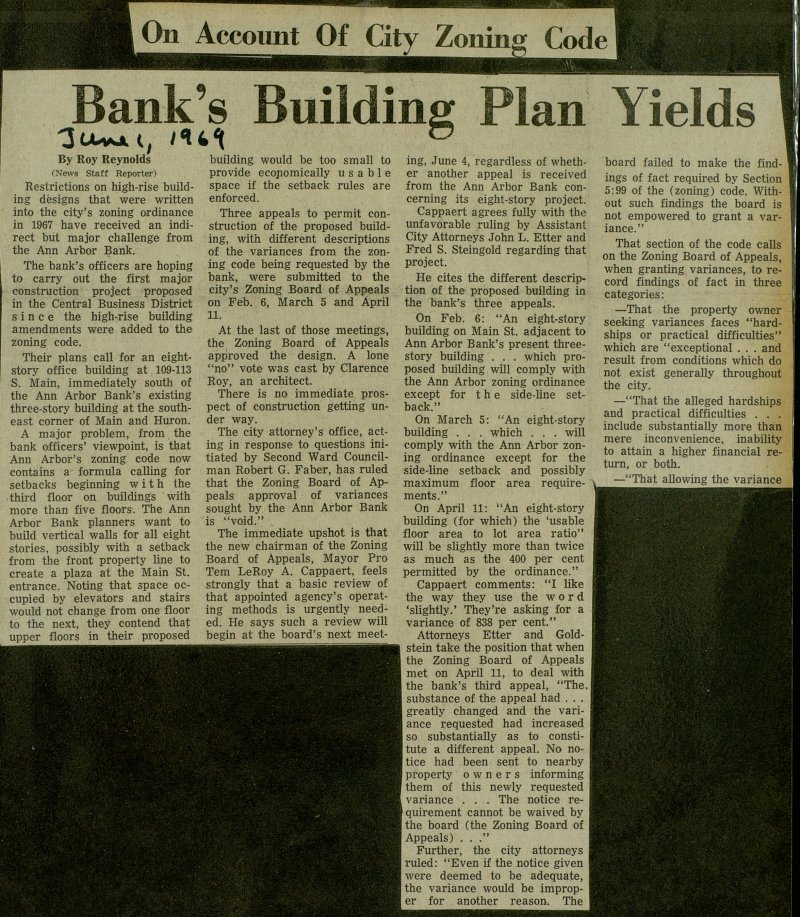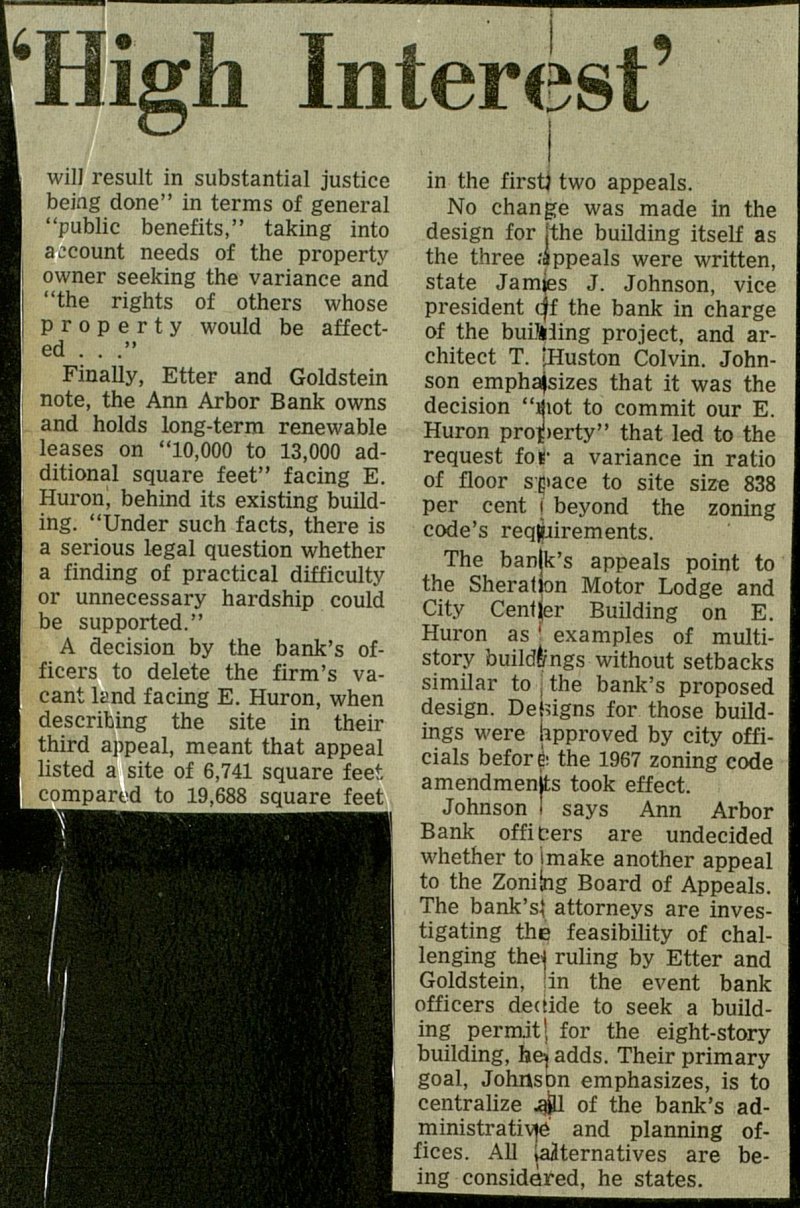Bank's Building Plan Yields


Restrictions on high-rise building designs that were written into the city's zoning ordinance in 1967 have received an indirect büt major challenge from the Ann Arbor Bank. The bank's officers are hoping to carry out the first major construction project proposed in the Central Business District s i n c e the high-rise building amendments were added to the zoning code. Their plans cali for an eightstory office building at 109-113 S. Main, immediately south of the Ann Arbor Bank's existing three-story building at the southeast corner of Main and Hurón. A major problem, from the bank officers' viewpoint, is that Ann Arbor's zoning code now contains a formula calling for setbacks beginning w i t h the third floor on buildings with more than five floors. The Ann Arbor Bank planners want to build vertical walls for all eight stories, possibly with a setback from the front property line to créate a plaza at the Main St. entrance. Noting that space occupied by elevators and stairs would not change from one floor to the next, they contend that upper floors in their proposed building would be too small to provide ecojiomically usable space if the setback rules are enforced. Three appeals to permit construction of the proposed building, with different descriptions of the variances from the zoning code being requested by the bank, were submitted to the city's Zoning Board of Appeals on Feb. 6, March 5 and April 11. At the last of those meetings, the Zoning Board of Appeals approved the design. A lone "no" vote was cast by Clarence Roy, an architect. There is no immediate prospect of construction getting under way. The city attorney's office, acting in response to questions initiated by Second Ward Councilman Robert G. Faber, has ruled that the Zoning Board of Appeals approval of variances sought by the Ann Arbor Bank is "void." The immediate upshot is that the new chairman of the Zoning Board of Appeals, Mayor Pro Tem LeRoy A. Cappaert, feels strongly that a basic review of that appointed agency's operating methods is urgently needed. He says such a review will begin at the board's next ing, June 4, regardless of whether another appeal is received from the Ann Arbor Bank concerning its eight-story project. Cappaert agrees fully with the unfavorable ruling by Assistant City Attorneys John L. Etter and Fred S. Steingold regarding that project. He cites the different description of the proposed building in the bank's three appeals. On Feb. 6: "An eight-story building on Main St. adjacent to Ann Arbor Bank's present threestory building . . . which proposed building will comply with the Ann Arbor zoning ordinance except for the side-line setback." On March 5: "An eight-story building . . . which . . . will comply with the Ann Arbor zoning ordinance except for the side-line setback and possibly maximum floor area requirements." On April 11: "An eight-story building (for which) the 'usable floor area to lot area ratio" will be slightly more than twice as much as the 400 per cent permitted by the ordinance." Cappaert comments: "I like the way they use the word 'slightly.' They 're asking for a variance of 838 per cent." Attorneys Etter and Goldstein take the position that when the Zoning Board of Appeals met on April 11, to deal with the bank's third appeal, "The. substance of the appeal had . . . greatly changed and the variance requested had increased so substantially as to constitute a different appeal. No notice had been sent to nearby property o w n e r s informing them of this newly requested variance . . . The notice requirement cannot be waived by the board (the Zoning Board of Appeals) ..." Further, the city attorneys ruled: "Even if the notice given were deemed to be adequate, the variance would be improper for another reason. The board failed to make the 1 ings of fact required by Section I 5:99 of the (zoning) code. I out such findings the board is I not empowered to grant a I iance." That section of the code calis on the Zoning Board of Appeals, when granting variances, to record findings of fact in three categories: - That the property owner seeking variances faces "hardships or practical difficulties" which are "exceptional . . . and result from conditions which do not exist generally throughout the city. -"That the alleged hardships and practical difficulties . . . include substantially more than mere inconvenience, inability to attain a higher financial return, or both. - "That allowing the variance will result in substantial justice being done" in terms of general "public benefits," taking into account needs of the property owner seeking the variance and "the rights of others whose property would be affected . . ." Finally, Etter and Goldstein note, the Ann Arbor Bank owns and holds long-term renewable leases on "10,000 to 13,000 additional square feet" facing E. Huron, behind its existing building. "Under such facts, there is a serious legal question whether a finding of practical difficulty or unnecessary hardship could be supported." A decisión by the bank's officers to delete the firm's vacant land facing E. Huron, when describing the site in their third appeal, meant that appeal listed a site of 6,741 square feet compared to 19,688 square feet in the firstí two appeals. No change was made in the design for Ithe building itself as the three ;4ppeals were written, state Jamjes J. Johnson, vice president f the bank in charge of the buiiiing project, and architect T. Huston Colvin. Johnson emphajsizes that it was the decisión "tíiot to commit our E. Huron proerty" that led to the request for a variance in ratio of floor sfiace to site size 838 per cent i beyond the zoning code's reqjjirements. The banjk's appeals point to the Sheratjon Motor Lodge and City Center Building on E. Huron as I examples of multistory buildfcngs without setbacks similar to the bank's proposed design. DeBigns for those buildings were jipproved by city officials befor è the 1967 zoning code amendmenjts took effect. Johnson I says Ann Arbor Bank offiCers are undecided whether to imake another appeal to the ZoniSng Board of Appeals. The bank's} attorneys are investigating the feasibility of challenging the ruling by Etter and Goldstein, in the event bank officers dectide to seek a building permit' for the eight-story building, headds. Their primary goal, JohnsDn emphasizes, is to centralize 1 of the bank's administrativ)é and planning offices. All iaiternatives are being considared, he states.